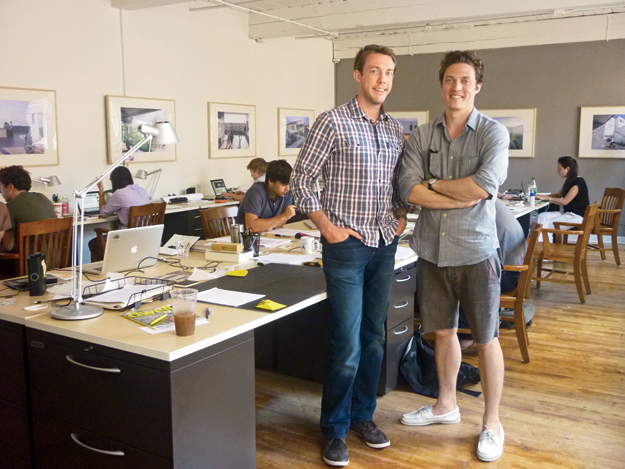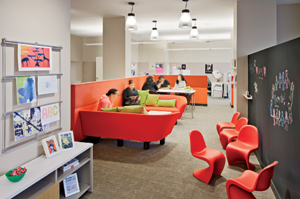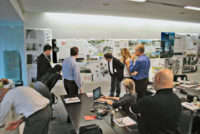
Michael Murphy (right) and Alan Ricks founded MASS in 2008 while students at the Harvard GSD.
Photo © Architectural Record / Jenna M. McKnight
Architects devoted to humanitarian work are finding ways to make ends meet.
In tough times, architects find it hard to say no to clients who can help them make the payroll, even if the potential projects won't show off the firm at its best. And if a firm plays in the big leagues, its principals are hotly pursuing those few golden commissions that not only earn big fees but also garner media attention. That doesn't leave much time or resources for pro bono design.

Founded in 1991, Raleigh-based Design Corps has focused on creating structures for migrant workers, including housing and chicken coops.
Photo © Emily Axtman / Design Corps
Some architects, however, are challenging that model for running an office. Whether creating parks in poor neighborhoods, aiding in post-disaster situations, or constructing migrant-worker housing, there are surprising numbers of designers intensely focused on socially conscious work. Their efforts are undoubtedly noble, yet the question remains: Can they possibly make a living doing it?
For MASS Design Group, the answer is yes. “Increasingly, architecture is serving the wealthy few. We've got to come up with new models to deliver fundamental services to communities that have been underserved,” says Michael Murphy, 32, executive director of the Boston-based nonprofit firm. MASS is an acronym for Model of Architecture Serving Society.
While still a student at Harvard's Graduate School of Design in 2008, Murphy founded MASS with five classmates. Their first major project was the roundly praised Butaro Hospital in Rwanda, funded by the U.S. foundation Partners In Health (PIH) and the Rwandan government, and completed in 2011. Most of the firm's work on the 65,000-square-foot project was done on a volunteer basis.
Now their higher profile in the humanitarian design field is leading to paying commissions. The firm has earned fees for its work on the design of a 22,000-square-foot tuberculosis hospital in Port-au-Prince, funded by GHESKIO, a local charity. MASS also earned fees for the design of a new wing for the historic Nyanza Maternity Hospital in Rwanda, a UNICEF project.
Until MASS acquires its pending not-for-profit tax status, PIH is serving as its “fiscal sponsor.” That means the fledgling firm must coordinate its fund-raising efforts—such as requesting donations through e-newsletters—with PIH. According to firm cofounder Alan Ricks, MASS is now garnering more than $400,000 a year in contributions from private foundations, corporations, and individual donors. Recent supporters include Herman Miller, the furniture manufacturer, which announced last fall it would sponsor an undetermined number of fellows. Today, MASS employs 21 people full-time, five of whom are supported by a yearlong fellowship program. The firm has outposts in Rwanda, Haiti, Boston, and Los Angeles.
Murphy spends half his time on business development, not design, but finds it rewarding. “I get to talk to people who believe that architecture can improve lives,” he says. And the firm is quickly earning accolades: It was named Contract magazine's 2012 Designer of the Year, and Forbes recently put Ricks on its “30 Under 30” list of notable artists and designers.
Still, in terms of its business model, MASS is in small company. Less than one percent of U.S. design firms are not-for-profit, a status determined by the Internal Revenue Service. If a firm has charitable goals, and if it reinvests all profits back into the organization, it will likely be awarded 501(c)(3) status, freeing it from paying federal income taxes.
But keeping these firms alive is challenging. About 250 nonprofit design groups (including architecture firms, advocacy organizations, and design centers) have launched in the past 50 years, but only about 100 remain, says Sharon Haar, a University of Illinois architecture professor who is writing a book about architecture as a force for social change. Most of the surviving nonprofits have emerged in the past 20 years, says Haar: “There's been a return to an interest in the broader social dimensions of architecture” that hasn't been seen since the early 1970s.
Bryan Bell is a pioneer in the recent resurgence. In 1991, after a short stint in Steven Holl's office, he founded Design Corps, a Raleigh-based nonprofit firm that now employs two full- and two part-time staffers. For its first decade, the studio primarily designed migrant worker housing, about 150 units in total, funded mostly through federal grants. The U.S. Department of Housing and Urban Development supplied three grants totaling $1.1 million, and the National Endowment for the Arts kicked in six grants totaling $600,000. In addition, the U.S. Department of Agriculture (USDA) has contributed about $600,000 over the years.
“I had never heard of the USDA when I graduated from Yale,” Bell says. “But if you look at all the funding sources in government that have design potential to them, you're talking about hundreds of billions of dollars.”
Since 2000, Bell has offered socially conscious architects two-day training sessions around the country through his Public Interest Design Institute. A recent session at Yale drew about 50 attendees and included speakers such as David Perkes, the founding director of the Gulf Coast Community Design Studio, and Austrian architect Anna Heringer, whose “Handmade School” in Bangladesh has received wide acclaim and was exhibited at the Museum of Modern Art in New York.
In fact, individual architects of all ages are becoming more interested in socially activist work. Charles Newman, who earned a B. Arch. from Syracuse University in 2005, worked in New York City for several different offices. By 2008, however, he had grown weary of the “academic undertones of the sleekarchitecture firms.” Today, the 29-year-old designer is a construction manager in the Democratic Republic of Congo, where he builds schools, bridges, and clinics for the International Rescue Committee, which gives him a salary and benefits. Previously, Newman spent two years working on and off in Haiti in the wake of the 2010 earthquake. “Getting out into this world has helped me rediscover the value of design on a more intimate scale,” he says.
Similarly, Kate Evarts, a mid-career professional who logged 25 years in conventional firms in New York and Seattle, is now in Haiti on an 18-month Architecture for Humanity fellowship to rebuild schools damaged by the quake. The job doesn't exactly pay the bills. Although she receives a small stipend for her Haiti work, she must use her savings to cover some living expenses, a mortgage, and a child's college tuition. Still, the monetary trade-off is worth it. “My time in Haiti has been rewarding in surprising ways,” she says, “as I've gotten back to the basics of what I loved about architecture.”
C. J. Hughes is a New York City–based writer and contributing editor at Architectural Record.
Despite concerns about the pitfalls of donated design services, The 1% program is gaining traction.

Perkins + Will designed a center for GEMS, which aids former teenage prostitutes.
Photo © Eduard Hueber
The growing desire among designers to help the less fortunate is welcome news to John Peterson, founder of Public Architecture. In 2005, the San Francisco'based nonprofit firm, with support from a National Endowment for the Arts grant, launched The 1% program, which encourages firms to donate 1 percent of their total working hours to philanthropic causes.
So far, about 950 firms, large and small, have signed on. In May, the program will get a huge boost when the AIA launches a database to track firms’ pro bono contributions. The AIA’s involvement suggests that “we have moved closer to the institutionalization of pro bono practices,” Peterson says.
Other professions have long advocated for giving back. Lawyers are expected to put in 50 hours of pro bono service a year, according to the American Bar Association, and the American Medical Association strongly encourages charity work as well. No standards exist in architecture, although the AIA’s Code of Ethics does state that members “should promote and serve the public interest in their personal and professional activities.” Some argue that architects shouldn’t design for free because it eliminates much-needed paying jobs. Others say pro bono work can be haphazard and ineffectual: A large firm might volunteer to design a master plan for a town but not oversee its long-term implementation.
Yet when big firms do donate time, the impact can be significant. A case in point: Annual contributions by HOK, with 1,900 people on the payroll, are the equivalent of 25 employees working exclusively pro bono, firm principals say. Definitive projects have resulted, such as a 3,500-square-foot office for the Taproot Foundation, a San Francisco-based nonprofit that helps other charities get access to marketing, finance, and other services. The project was finished in 2010.
Similarly, Perkins + Will, another 1%-er, designed the New York center for Girls Educational & Mentoring Services (GEMS), which aids former teenage prostitutes. Awash in bright yellow and orange walls, the 1,700-square-foot space was completed last year.
Pro bono work can boost employee morale and, yes, it can enhance a firm’s public image, says Clark Davis, HOK’s vice chairman. But he believes that it also taps into a deeper impulse: “There is something in our DNA as architects and designers that causes us to care.”


Post a comment to this article
Report Abusive Comment